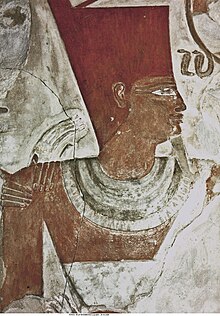
Back Mentoehotep II Afrikaans 2 መንቱሆተፕ Amharic منتوحوتب الثاني Arabic منتوحوتب التانى ARZ II Mentuhotep Azerbaijani Ментухатэп II Byelorussian Mentuhotep I Catalan Mentuhotep II. Czech Ментухотеп II CV Mentuhotep II. German
| Mentuhotep II | ||||||||||||||||||||||||||||||||||||||||||||||||||||||||||||||||||||||||||||||||||||||||||||||||||||||||||
|---|---|---|---|---|---|---|---|---|---|---|---|---|---|---|---|---|---|---|---|---|---|---|---|---|---|---|---|---|---|---|---|---|---|---|---|---|---|---|---|---|---|---|---|---|---|---|---|---|---|---|---|---|---|---|---|---|---|---|---|---|---|---|---|---|---|---|---|---|---|---|---|---|---|---|---|---|---|---|---|---|---|---|---|---|---|---|---|---|---|---|---|---|---|---|---|---|---|---|---|---|---|---|---|---|---|---|
 Relief showing Mentuhotep II in front of Montu from his mortuary temple in Deir el Bahri, Londres | ||||||||||||||||||||||||||||||||||||||||||||||||||||||||||||||||||||||||||||||||||||||||||||||||||||||||||
| Pharaoh | ||||||||||||||||||||||||||||||||||||||||||||||||||||||||||||||||||||||||||||||||||||||||||||||||||||||||||
| Reign | 2060–2009 BC[1] | |||||||||||||||||||||||||||||||||||||||||||||||||||||||||||||||||||||||||||||||||||||||||||||||||||||||||
| Predecessor | Intef III | |||||||||||||||||||||||||||||||||||||||||||||||||||||||||||||||||||||||||||||||||||||||||||||||||||||||||
| Successor | Mentuhotep III | |||||||||||||||||||||||||||||||||||||||||||||||||||||||||||||||||||||||||||||||||||||||||||||||||||||||||
| ||||||||||||||||||||||||||||||||||||||||||||||||||||||||||||||||||||||||||||||||||||||||||||||||||||||||||
| Consort | Tem, Neferu II, Ashayet, Henhenet, Kawit, Kemsit, Sadeh | |||||||||||||||||||||||||||||||||||||||||||||||||||||||||||||||||||||||||||||||||||||||||||||||||||||||||
| Children | Mentuhotep III, Mayet(?) | |||||||||||||||||||||||||||||||||||||||||||||||||||||||||||||||||||||||||||||||||||||||||||||||||||||||||
| Father | Intef III | |||||||||||||||||||||||||||||||||||||||||||||||||||||||||||||||||||||||||||||||||||||||||||||||||||||||||
| Mother | Iah | |||||||||||||||||||||||||||||||||||||||||||||||||||||||||||||||||||||||||||||||||||||||||||||||||||||||||
| Died | 2009 BC ? | |||||||||||||||||||||||||||||||||||||||||||||||||||||||||||||||||||||||||||||||||||||||||||||||||||||||||
| Burial | mortuary temple at Deir-el-Bahri | |||||||||||||||||||||||||||||||||||||||||||||||||||||||||||||||||||||||||||||||||||||||||||||||||||||||||
| Dynasty | 11th Dynasty | |||||||||||||||||||||||||||||||||||||||||||||||||||||||||||||||||||||||||||||||||||||||||||||||||||||||||
Mentuhotep II (Ancient Egyptian: Mn-ṯw-ḥtp, meaning "Mentu is satisfied"), also known under his prenomen Nebhepetre (Ancient Egyptian: Nb-ḥpt-Rˁ, meaning "The Lord of the rudder is Ra"), was an ancient Egyptian pharaoh, the sixth ruler of the Eleventh Dynasty. He is credited with reuniting Egypt, thus ending the turbulent First Intermediate Period and becoming the first pharaoh of the Middle Kingdom. He reigned for 51 years, according to the Turin King List.[5] Mentuhotep II succeeded his father Intef III on the throne and was in turn succeeded by his son Mentuhotep III.
Mentuhotep II ascended Egypt's throne in the Upper Egyptian city of Thebes during the First Intermediate Period. Egypt was not unified during this time, and the Tenth Dynasty, rival to Mentuhotep's Eleventh, ruled Lower Egypt from Herakleopolis. After the Herakleopolitan kings desecrated the sacred ancient royal necropolis of Abydos in Upper Egypt in the fourteenth year of Mentuhotep's reign, Pharaoh Mentuhotep II dispatched his armies north to conquer Lower Egypt. Continuing his father Intef III's conquests, Mentuhotep succeeded in unifying his country, probably shortly before his 39th year on the throne.[6][7] Following and in recognition of the unification, in regnal year 39, he changed his titulary to Sematawy (Ancient Egyptian: Smȝ-tȝ.w(j), meaning "He who unifies the two lands").[8]
Following the unification, Mentuhotep II reformed Egypt's government. To reverse the decentralization of power, which contributed to the collapse of the Old Kingdom and marked the First Intermediate Period, he centralized the state in Thebes to strip nomarchs of some of their power over the regions. Mentuhotep II also created new governmental posts whose occupants were Theban men loyal to him, giving the pharaoh more control over his country. Officials from the capital travelled the country regularly to control regional leaders.[9]
Mentuhotep II was buried at the Theban necropolis of Deir el-Bahari. His mortuary temple was one of Mentuhotep II's most ambitious building-projects, and included several architectural and religious innovations. For example, it included terraces and covered walkways around the central structure, and it was the first mortuary temple that identified the pharaoh with the god Osiris. His temple inspired several later temples, such as those of Hatshepsut and Thutmose III of the Eighteenth Dynasty.[9] Some depictions of Mentuhotep II seem to indicate that he suffered from elephantiasis, resulting in swollen legs.[10][11]
- ^ Stewart, John (2006). African States and Rulers (Third ed.). London: McFarland. p. 81. ISBN 0-7864-2562-8.
- ^ Alan H. Gardiner: The royal canon of Turin.
- ^ "Ancient Egypt - Dynasty XI". www.narmer.pl.
- ^ Peter Clayton: Chronicle of the Pharaohs: The Reign-by-Reign Record of the Rulers and Dynasties of Ancient Egypt, Thames & Hudson, p. 72. 2006. ISBN 0-500-28628-0
- ^ "The Ancient Egypt Site". www.ancient-egypt.org.
- ^ Grajetzki, The Middle Kingdom, p. 19
- ^ Franke, Detlef (1988). "Zur Chronologie des Mittleren Reiches Teil II: Die sogenannte "Zweite Zwischenzeit" Altägyptens". Orientalia. Nova Series (in German). 57 (3). Gregorian Biblical Press: 133. ISSN 0030-5367. JSTOR 3793107.
- ^ Vandersleyen, Claude (1994). "La titulature de Montouhotep II". In Bryan, Betsy Morrell; Lorton, David (eds.). Essays in Egyptology in honor of Hans Goedicke (in Italian). San Antonio, Texas: Van Siclen Books. pp. 317–320. ISBN 093317540X. OCLC 34552368.
- ^ a b Callender, Gae (2003) [2000]. "The Middle Kingdom Renaissance (c.2055–1650 BC)". In Shaw, Ian (ed.). The Oxford History of Ancient Egypt. Oxford, New York: Oxford University Press. ISBN 9780191604621.
- ^ "History of Parasitology". Cairo University Parasitology Department. Retrieved 2 June 2022.
- ^ "Statue of King Mentuhotep II in the Jubilee Garment (c. 2051-2000 B.C.) From Thebes, Deir el-Bahri". Research Gate. Retrieved 2 June 2022.
